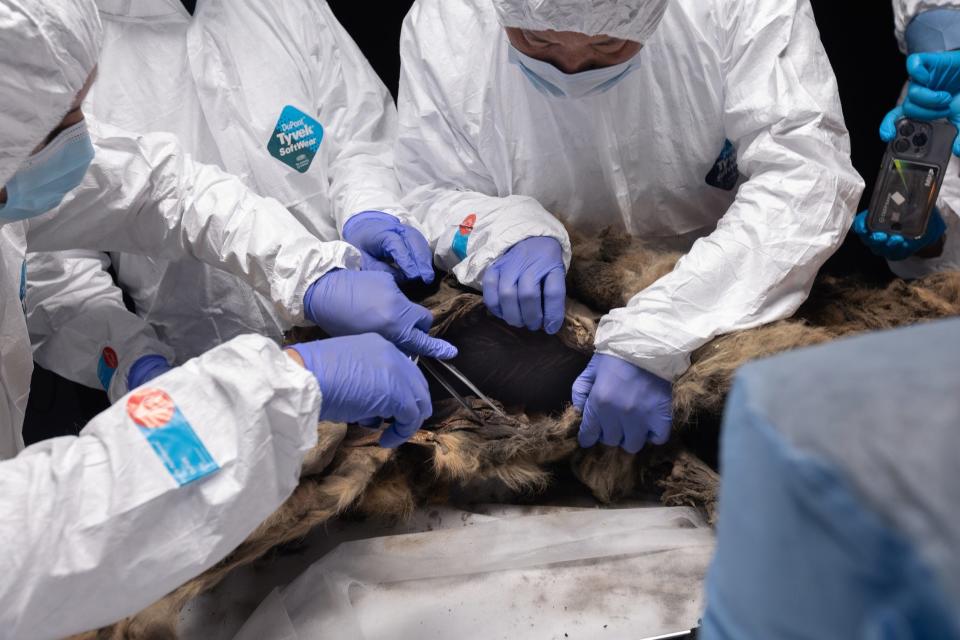A frozen wolf discovered in Siberia turned out to be 44,000 years old. It's so well-preserved that scientists are checking its gut for ancient viruses.
Researchers are studying a 44,000-year-old mummified wolf found in the permafrost in Russia.
The wolf may tell scientists what its lifestyle and diet were like during the Pleistocene era.
Researchers hope to learn more about ancient bacteria and how the wolf is related to modern animals.
This wolf looks pretty good for its age, considering it's 44,000 years old.
In 2021, residents of Yakutia in eastern Russia found the wolf in thick permafrost — soil that normally remains frozen year-round, but in many places has begun to thaw as average global temperatures rise.
Now, researchers at North-Eastern Federal University in Yakutsk, Russia, are studying the mummified remains to learn more about the animal.
The frozen conditions helped mummify and perfectly preserve the Pleistocene predator. Its teeth and much of its fur are still intact, as are some of its organs.

"It's shocking, actually," Robert Losey, an anthropologist at the University of Alberta who wasn't involved in the research, told Business Insider.
"It's the only complete adult Pleistocene wolf that's ever been found, so that in itself is really remarkable and completely unique," he added.
There's a lot to learn from such a well-preserved ancient animal, including its genetics, lifestyle, diet, and even what kind of ancient bacteria and viruses it had.
"Living bacteria can survive for thousands of years, which are a kind of witnesses of those ancient times," Artemy Goncharov, a researcher at the Institute of Experimental Medicine, said in a translated statement.
The wolf's stomach may hold its last meal and much more

This 44,000-year-old wolf likely belongs to an extinct species and was probably larger than modern wolves, Losey said. Studying the animal's genome will help reveal where it fits into the canine family tree.
After examining one of its teeth, the scientists believe the wolf was an adult male. It probably hunted in a flat, cold environment full of mammoths, wooly rhinoceroses, extinct horses, bison, and reindeer.
Remains of some of those animals might even be left in the wolf's gut. Researchers took samples of its stomach and digestive tract to learn more and are awaiting results.
The researchers may also be able to tease out what functions ancient microbes performed in the wolf's gut, and whether it had parasites, Losey said. If any of the microorganisms are unknown to science, they could play a role in the development of future medicines, the researchers said in the statement.
This discovery is just part of a larger collaboration to study other ancient animals, including fossil hares, a horse, and a bear. The researchers previously studied a wolf head from the Pleistocene era and have another wolf fossil awaiting dissection.
Ancient animals and infectious agents are thawing

As the world's permafrost thaws due to rising global temperatures, more ancient creatures like this are re-emerging. In the Yukon, for example, paleontologists are still fawning over an impeccably preserved baby mammoth discovered in 2022.
Not everything in the permafrost is so harmless, though.
In 2016, thawing in Siberia's Yamal Peninsula released anthrax from a once-frozen reindeer carcass, causing an outbreak that infected 36 people and killed one child.
Researchers fear that other pathogens may slumber in the tundra, with the thaw of a warming world slowly creeping toward them.
Last year, researcher Jean-Michel Claverie announced that he had revived a 48,000-year-old virus they found in the Siberian permafrost. It could still infect single-celled amoebas.
"We view these amoeba-infecting viruses as surrogates for all other possible viruses that might be in permafrost," Claverie told CNN at the time. "We see the traces of many, many, many other viruses. So we know they are there. We don't know for sure that they are still alive."
Any ancient viruses or bacteria in the guts of the Yakutia wolf could help researchers better understand the microbes hiding inside permafrost creatures.
Read the original article on Business Insider


